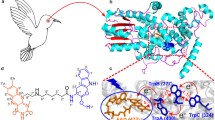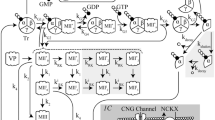Abstract
In experimental studies, we could show that the visual threshold of man is influenced by the geomagnetic field. One of the results was that the threshold shows periodic fluctuations when the vertical component of the field is reversed periodically. The maximum of these oscillations occurred at a period duration of 110 s. To explain this phenomenon, we chose the process that likely underlies the navigation of birds in the geomagnetic field: the light reaction of the FAD component of cryptochrome in the retina. The human retina contains cryptpochrome like the bird retina. Based on the investigations of Müller and Ahmad (J Biol Chem 286:21033–21040, 2011) and Solov’yov and Schulten (J Phys Chem B 116:1089–1099, 2012), we designed a model of the light-induced reduction and subsequent reoxidation of FAD. This model contains a radical pair, whose interconversion dynamics are affected by the geomagnetic field. The parameters of the model were partly calculated from the data of our experimental investigation and partly taken from the results of other authors. These parameters were then optimized by adjusting the model behaviour to the experimental results. The simulation of the finished model shows that the concentrations of all substances included show really oscillations with the frequency of the modelled magnetic field. After optimization of the parameters, the oscillations of FAD and FADH* show maximal amplitude at a period duration of 110 s, as was observed in the experiment. This makes it most likely that the signal, which influences the visual system, originates from FADH* (signalling state).






Similar content being viewed by others
References
Evans EW, Dodson CA, Maeda K, Biskup T, Wedge CJ, Timmel CR (2013) Magnetic field effects in flavoproteins and related systems. Interface Focus 3:20130037
Foley LE, Gegear RJ, Reppert SM (2011) Human cryptochrome exhibits light-dependent magnetosensitivity. Nat Commun 2:356. doi:10.1038/ncomms1364
Gauden M, van Stokkum IHM, Key JM, Lührs DCh, van Grondelle R, Hegemann P, Kennis JTM (2006) Hydrogen-bond switching trough a radical pair mechanism in a flavin-binding photoreceptor. PNAS 103:10895–10900
Gegear RJ, Casselman A, Waddell S, Reppert SM (2008) Cryptochrome mediates light-dependent magnetosensitivity in Drosophila. Nature 454:1014–1019
Grissom CB (1995) Magnetic fields effects in biology: a survey of possible mechanisms with emphasis on radical-pair recombination. Chem Rev 95:3–24
Hogben HJ, Efimova O, Wagner-Rundell N, Timmel CR, Hore PJ (2009) Possible involvement of superoxide and dioxygen with cryptochrome in avian magnetoreception: origin of Zeeman resonances observed by in vivo EPR spectroscopy. Chem Phys Lett 480:118–122
Lee AA, Lau JCS, Hogben HJ, Biskup T, Kattnig DR, Hore PJ (2014) Alternative radical pairs for cryptochrome-based magnetoreception. J R Soc Interface 11:20131063
Liedvogel M, Madea K, Henbest K, Schleicher E, Simon T, Timmel CR, Hore PJ, Mouritsen H (2007) Chemical magnetoreception: bird cryptochrome 1a is exited by blue light and forms long-lived radical-pairs. PLoS ONE 2:e1106
Möller A, Sagasser S, Wiltschko W, Schierwater B (2004) Retinal cryptochrome in a migratory passerine bird: a possible transducer for the avian magnetic compass. Naturwissenschaften 91:585–588
Mouritsen H, Janssen-Bienhold U, Liedvogel M, Feenders G, Stalleicken J, Dirks P, Weiler R (2004) Cryptochomes and neural activity-markers colocalize in the retina of migratory birds during magnetic orientation. PNAS 101:14294–14299
Müller P, Ahmad M (2011) Light activated cryptochrome reacts with molecular oxygen to form a flavin-superoxide radical pair consistent with magnetoreception. J Biol Chem 286:21033–21040
Müller P, Yamamoto J, Martin R, Iwai S, Brettel K (2015) Discovery and functional analysis of a \(4^{\text{ th }}\) electron-transferring tryptophan conserved exclusively in animal cryptochromes and (6–4) photolyases. Chem Commun 51:15502
Nießner C, Denzau S, Stapput K, Ahmad M, Peichl L, Wiltschko W, Wiltschko R (2013) Magnetoreception: activated cryptochrome 1a concurs with magnetic orientation in birds. J R Soc Interface 10:20130638
Nießner C, Denzau S, Peichl L, Wiltschko W, Wiltschko R (2014) Magnetoreception in birds: I. Immunohistochemical studies concerning the cryptochrome cycle. J Exp Biol 217:4221–4224
Ritz T, Adern S, Schulten K (2000) A model for photoreceptor based magnetoreception in birds. Biophys J 78:707–718
Ritz T, Wiltschko R, Hore PJ, Rodgers CT, Stapput K, Thalau P, Timmel CR, Wiltschko W (2009) Magnetic compass of birds is based on a molecule with optimal directional sensitivity. Biophys J 96:3451–3457
Rodgers CT, Hore PJ (2009) Chemical magnetoreception in birds: the radical pair mechanism. PNAS 106:353–360
Schulten K, Windemuth A (1986) A model for a physiological magnetic compass. In: Maret G (ed) Biophysical effects of steady magnetic fields. Springer, Berlin, pp 99–106
Solov’yov IA, Schulten K (2009) Magnetoreception through cryptochrome may involve superoxide. Biophys J 96:4804–4813
Solov’yov IA, Schulten K (2012) Reaction kinetics and mechanisms of magnetic field effects in cryptochrome. J Phys Chem B 116:1089–1099
Thompson CL, Bowes Rickman C, Shaw SJ, Ebright JN, Kelly U, Sancar A, Rickman DW (2003) Expression of the blue-light receptor cryptochrome in the human retina. Invest Ophthalmol Vis Sci 44:4515–4521
Thoss F, Bartsch B (2007) The geomagnetic field influences the sensitivity of our eyes. Vis Res 47:1036–1041
Thoss F, Bartsch B, Fritzsche B, Tellschaft D, Thoss M (2000) The magnetic field sensitivity of the human visual system shows resonance and compass characteristic. J Comp Physiol A 186:1007–1010
Timmel CR, Till U, Brocklehurst B, McLauchlan KA, Hore PJ (1998) Effects of weak magnetic fields on free radical recombination reactions. Mol Phys 95:71–89
Wiltschko R, Wiltschko W (2014) Sensing magnetic directions in birds: radical pair processes involving cryptochrome. Biosensors 4:221–242
Wiltschko R, Gehring D, Denzau S, Nießner C, Wiltschko W (2014) Magnetoreception in birds: II. Behavioural experiments concerning the cryptochrome cycle. J Exp Biol 217:4225–4228
Author information
Authors and Affiliations
Corresponding author
Additional information
We dedicate this paper to the memory of Professor Hans Drischel ( $$\dagger $$ † ), one of the founders of Biocybernetics in Germany and worldwide, on the occasion of his 100th birthday on June 8, 2015.
Electronic supplementary material
Below is the link to the electronic supplementary material.
Rights and permissions
About this article
Cite this article
Thoss, F., Bartsch, B. A model of the FAD redox cycle describes the dynamics of the effect of the geomagnetic field on the human visual system. Biol Cybern 111, 347–352 (2017). https://doi.org/10.1007/s00422-017-0725-y
Received:
Accepted:
Published:
Issue Date:
DOI: https://doi.org/10.1007/s00422-017-0725-y




